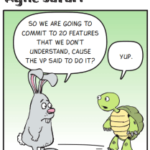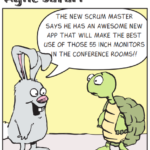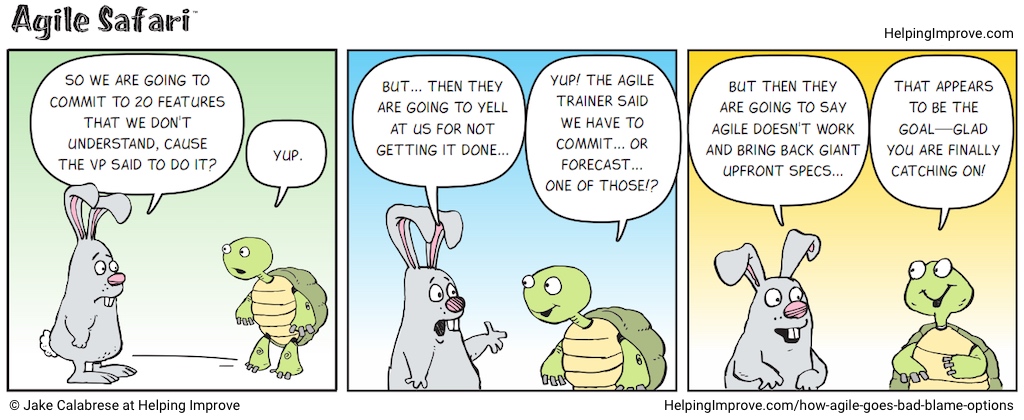
ScrumMaster
Agile Safari – Best Agile Project Management Software
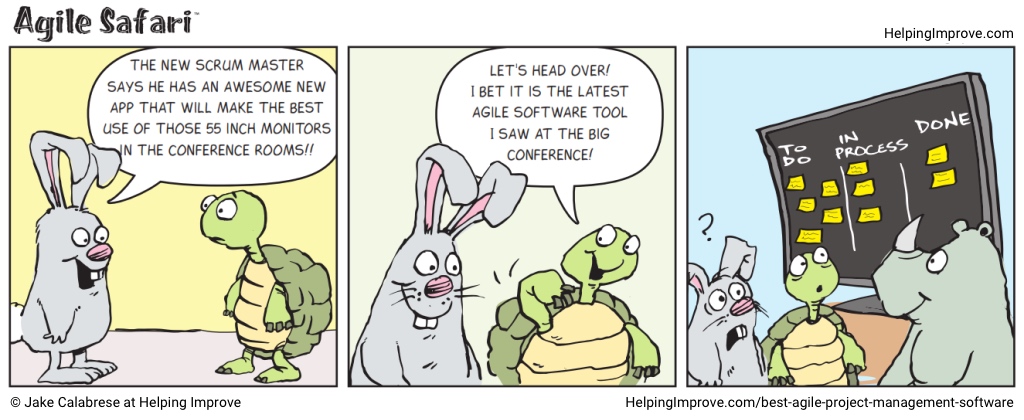
No, I don’t hate agile project management software — it can serve a purpose. At issue is if there is an actual purpose and if it is misused. Often the software stalls progress or worse, move us backwards. For any readers who are not familiar with agile or don’t work in software — the idea here is that instead of using the monitor to display some type of software tracking tool, the new scrum master just used sticky-notes and stuck them on the monitor. What is the simplest thing that works in your world?
Agile Safari – What’s Not Being Said?
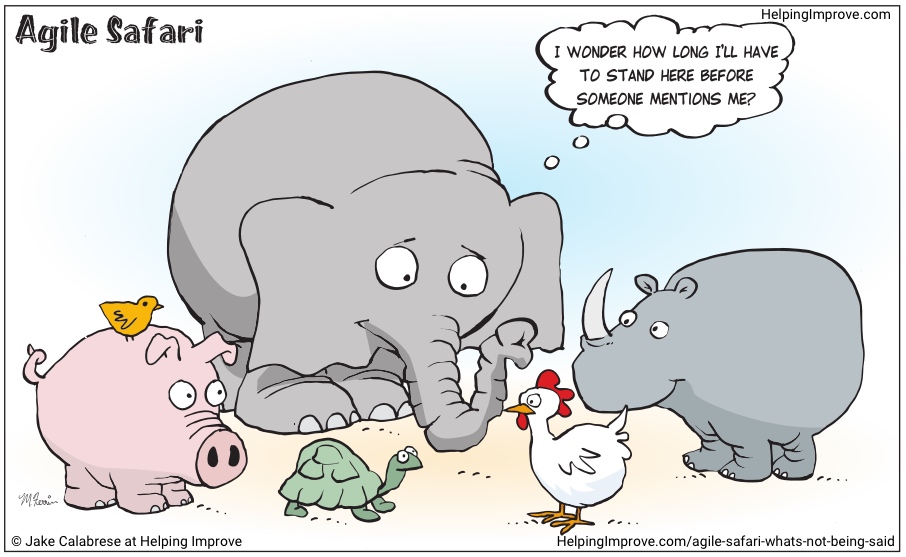
Have you been in a situation where no one would bring up the problem that everyone knew was “in the room?” I’d guess that everyone has been there. So often, we don’t bring up the “elephant in the room.” For anyone who has not heard of this, the elephant in the room is a saying for the real or obvious truth that is not being addressed. Given an elephant in a room would be hard to miss, when people ignore it, they are typically pretending it is not there.
The Real Baseline Agile Retrospective Format
I always considered this six question format to be the Baseline Agile Retrospective Format. I say baseline instead of standard because a baseline is something to build on, not an ‘always the way’ standard (I know I’m splitting hairs here).
I believe the six question baseline agile retrospective format is a solid way to teach people how to do an agile retrospective. They can see, relatively clearly, the different parts that should be included. It can be a useful starting point to address additional questions and challenges.
Bad Standard: Plus-Minus-Delta Agile Retrospectives
Many people dislike the 3 question, plus-minus-delta retrospective. I am one of them. The plus-minus-delta agile retrospective leads to many problems. I say it was never the “standard” in the title, so why are so many people confused? Or…am I the one confused?
While co-coaching recently, the other coach and I had a brief exchange about how the “standard” agile retrospective was not good. I was a little confused, since while I certainly do not always use ‘the standard’ or baseline agile retrospective, there is value to it — at least I thought so? The baseline retrospective I employ is a solid method to teach people how to do an agile retrospective. I asked a few more questions and realized that while we were both using the term “standard retrospective,” we had different definitions of the term.
Learning with Fist of Five Voting
Fist of Five Voting is a deceivingly simple process you can use to check-in, learn, gain consensus, and/or vote to understand where people stand on an issue or idea. I say deceivingly, because there is so much more you can learn about what is really happening in a team if you are paying attention.
I find there are many tools I (and others) use without being entirely sure of the idea’s origin. As I work on other articles, I realize some people may not be familiar with concepts such as Fist of Five Voting. So I’m working on building these ideas out to fill in those gaps. The source of Fist of Five is sometimes attributed to American Youth Foundation, however I can’t find a reference on their website.
Lessons-Learned vs Project Retrospectives
I wrote about agile team retrospectives in a recent article and find that the term retrospective can be used in many different ways. I’ve heard people ask, “Did you just change the name from lessons-learned to retrospective?” Although there are similarities, there are some key differences. Let’s review a few types and consider the issues with most lessons-learned meeting.
Release and Project Retrospectives
While agile team retrospectives have a team focus on celebrating, learning, and improving their relationship on a regular basis, there are other types of retrospectives.
Agile Retrospective Resources
There is a lot of information out there are agile retrospectives. I have a number of articles on them and there are plenty of places with information including blogs, websites, and books.
My Articles About Agile Retrospectives
I’m working on a series about retrospectives, and have included a list of articles that are already written as well as some of the future articles. If you are interested in subscribing to get notified of the next post, please subscribe via email.
Agile Area Rugs- Covering Opportunities with Longer Sprints?
Will longer agile sprints or iterations cover up opportunities to improve and cause you to view these opportunities as unsolvable problems?

The typical agile sprint size is 2 weeks. What percentage of teams use 2 weeks? I don’t have statistics on it, but I’d guess over 90%. I’m working on a product where we are doing 1 week sprints. It’s a startup and things are changing a lot so 1 week works well. I also know some teams that use 3 week sprints and it is working for them. I’m not saying it has to be a certain number of weeks – but please don’t kid yourself with what length will actually work for you.
I’ve seen situations where people are doing 3 week sprints, but then have a 1 week “hardening” sprint. Personally, I’m not a big fan of hardening sprints. I can see many “logical” arguments on why people need them, but in the 3+1 week sprints – I’d say stop kidding yourself. You have a 4 week sprint! Maybe that is the best you can do right now and you are ACTIVELY working to eliminate the hardening sprint – but if you believe you will always need one you are likely stuck.
Thoughts on Professional Coaching
I get a lot of questions about coaching – what is it, what do you mean by the word ‘coach’, is it the same as mentoring, is coaching just asking questions… and many more.
Who do you coach?
I coach people. 🙂 These may be individuals, pairs, couples, teams, organizations, or systems.
Can you tell me more about what the word Coach means to you?
 The word ‘Coach’ tends to have a lot of different uses. When I talk about coaching, I am referring to professional coaching, which in the US, tends to be associated with standards laid out by the International Coaching Federation (ICF). I view coaching as helping people find the internal wisdom to achieve their goals by moving beyond whatever is stopping them or slowing them down. Coaching is NOT about telling people what to do or judging them – the coach may be an expert on “coaching” but is not the expert on the person or the goals they have. This is concept is misunderstood by a lot of people. A coach is not the person who says “do this” or “don’t do that”! Coaching is always about the clients agenda – NOT the coach’s! The coach relies on the client being fabulous, amazing, and wanting to move forward toward a goal! That sounds over the top to some, but it really isn’t, it’s about having faith in the person! The key is that as a coach, I need to fully believe that the person (or people or system) I am coaching has the wisdom to solve their challenges. They might need some help in finding or accessing that wisdom or working through different options, but they can access the information to let them move forward! This is not always an easy place to stand, but believing in the client is a fundamental part of professional coaching. It does not work without it.
The word ‘Coach’ tends to have a lot of different uses. When I talk about coaching, I am referring to professional coaching, which in the US, tends to be associated with standards laid out by the International Coaching Federation (ICF). I view coaching as helping people find the internal wisdom to achieve their goals by moving beyond whatever is stopping them or slowing them down. Coaching is NOT about telling people what to do or judging them – the coach may be an expert on “coaching” but is not the expert on the person or the goals they have. This is concept is misunderstood by a lot of people. A coach is not the person who says “do this” or “don’t do that”! Coaching is always about the clients agenda – NOT the coach’s! The coach relies on the client being fabulous, amazing, and wanting to move forward toward a goal! That sounds over the top to some, but it really isn’t, it’s about having faith in the person! The key is that as a coach, I need to fully believe that the person (or people or system) I am coaching has the wisdom to solve their challenges. They might need some help in finding or accessing that wisdom or working through different options, but they can access the information to let them move forward! This is not always an easy place to stand, but believing in the client is a fundamental part of professional coaching. It does not work without it.

